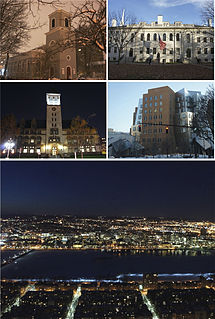
Cambridge is a city in Middlesex County, Massachusetts, and part of the Boston metropolitan area. As of July 2019, it was the fifth most populous city in the state, behind Boston, Worcester, Springfield, and Lowell. According to the 2010 Census, the city's population was 105,162. It is one of two de jure county seats of Middlesex County, although the county's government was abolished in 1997. Situated directly north of Boston, across the Charles River, it was named in honor of the University of Cambridge in England, once also an important center of the Puritan theology embraced by the town's founders.
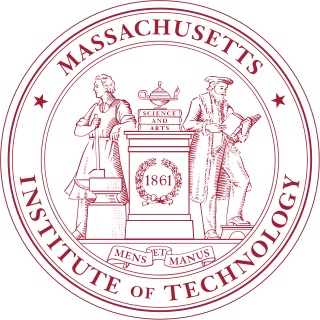
Massachusetts Institute of Technology (MIT) is a private research university in Cambridge, Massachusetts. The Institute is a land-grant, sea-grant, and space-grant university, with an urban campus that extends more than a mile (1.6 km) alongside the Charles River. The Institute also encompasses a number of major off-campus facilities such as the MIT Lincoln Laboratory, the Bates Center, and the Haystack Observatory, as well as affiliated laboratories such as the Broad and Whitehead Institutes. Founded in 1861 in response to the increasing industrialization of the United States, MIT adopted a European polytechnic university model and stressed laboratory instruction in applied science and engineering. It has since played a key role in the development of many aspects of modern science, engineering, mathematics, and technology, and is widely known for its innovation and academic strength.
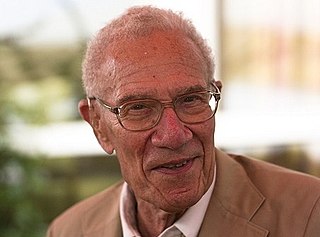
Robert Merton Solow, GCIH, is an American economist whose work on the theory of economic growth culminated in the exogenous growth model named after him. He is currently Emeritus Institute Professor of Economics at the Massachusetts Institute of Technology, where he has been a professor since 1949. He was awarded the John Bates Clark Medal in 1961, the Nobel Memorial Prize in Economic Sciences in 1987, and the Presidential Medal of Freedom in 2014. Four of his PhD students, George Akerlof, Joseph Stiglitz, Peter Diamond and William Nordhaus later received Nobel Memorial Prizes in Economic Sciences in their own right.
The Tech Model Railroad Club (TMRC) is a student organization at the Massachusetts Institute of Technology (MIT). Historically it has been a wellspring of hacker culture and the oldest such hacking group in North America. Formed in 1946, its HO scale layout specializes in automated operation of model trains.
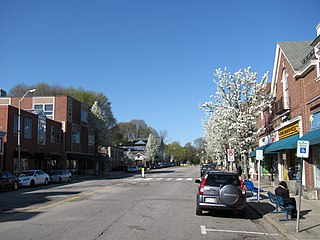
Belmont is a town in Middlesex County, Massachusetts. It is a western suburb of Boston, Massachusetts, United States; and is part of the greater Boston metropolitan area. Its population was 26,123 as of November 25, 2019.

Fernando José "Corby" Corbató was a prominent American computer scientist, notable as a pioneer in the development of time-sharing operating systems.

The Red Line is a rapid transit line operated by the Massachusetts Bay Transportation Authority (MBTA). It runs roughly northwest-to-southeast across Cambridge and Davis Square in Somerville – from Alewife in North Cambridge to Kendall/MIT in Kendall Square – with a connection to commuter rail at Porter. It then crosses over the Longfellow Bridge into downtown Boston, where it connects with the Green Line at Park Street, the Orange Line at Downtown Crossing, the Silver Line at South Station, as well as Amtrak and commuter rail at the South Station surface terminal before passing through South Boston and Dorchester. South of JFK/UMass in Dorchester, it splits into two branches terminating at Braintree and Ashmont stations; transfers to commuter rail are again possible at JFK/UMass, Quincy Center, and Braintree. From Ashmont, passengers may continue to Mattapan via the Ashmont–Mattapan High Speed Line, a 2.6-mile (4.2 km) light rail line.

Oscar Zariski was a Russian-born American mathematician and one of the most influential algebraic geometers of the 20th century.

Henry Hobson Richardson was a prominent American architect, best known for his work in a style that became known as Richardsonian Romanesque. Along with Louis Sullivan and Frank Lloyd Wright, Richardson is one of "the recognized trinity of American architecture".

Kendall/MIT is an underground rapid transit station in Cambridge, Massachusetts. It serves the MBTA Red Line, Located at the intersection of Main Street and Broadway, it is named for the primary areas it serves - the Kendall Square business district and the Massachusetts Institute of Technology (MIT). Opened in March 1912 as part of the original Cambridge Subway, Kendall/MIT has two side platforms serving the line's two tracks. The Kendall Band, a public art installation of hand-operated musical sculptures, is located between the tracks in the station with controls located on the platforms. Kendall/MIT station is fully handicapped accessible.

WMBR is the Massachusetts Institute of Technology's student-run college radio station, licensed to Cambridge, Massachusetts, and broadcasting on 88.1 FM. It is all-volunteer and funded by listener donations and MIT funds. Both students and community members can apply for positions, and like many college radio stations, WMBR offers diverse programming ranging from talk shows to music including RnB to electronic music.

The Grand Junction Railroad is an 8.55-mile (13.76 km) long railroad in the Boston, Massachusetts, area, connecting the railroads heading west and north from Boston. Most of it is still in use, carrying scrap either inbound or outbound to the Schnitzer scrap yard on the Everett waterfront or freight to the Chelsea Produce Market, and non-revenue transfers of Amtrak and MBTA passenger equipment between the lines terminating at North Station and South Station. The line is also notable for its railroad bridge over the Charles River that passes under the Boston University Bridge between Boston and Cambridge, Massachusetts.
The Urban Ring was a proposed project of the Massachusetts Bay Transportation Authority and the Massachusetts Department of Transportation, to develop new public transportation routes that would provide improved circumferential connections among many existing transit lines that project radially from downtown Boston. The Urban Ring Corridor is located roughly one to two miles from downtown Boston, passing through the Massachusetts cities of Boston, Chelsea, Everett, Medford, Somerville, Cambridge, and Brookline. The project was expected to convert 41,500 car trips to transit trips daily.
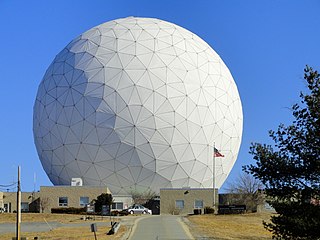
Haystack Observatory is an astronomical observatory owned by Massachusetts Institute of Technology (MIT). It is located in Westford, Massachusetts (US), approximately 45 kilometers (28 mi) northwest of Boston. Haystack was initially built by MIT's Lincoln Laboratory for the United States Air Force and was known as Haystack Microwave Research Facility. Construction began in 1960, and the antenna began operating in 1964. In 1970 the facility was transferred to MIT, which then formed the Northeast Radio Observatory Corporation (NEROC) with a number of other universities to operate the site as the Haystack Observatory. As of January 2012, a total of nine institutions participated in NEROC.
Terence Parsons is an American philosopher working in the analytic tradition, specializing in philosophy of language and metaphysics. He is emeritus professor of philosophy at UCLA.

The campus of the Massachusetts Institute of Technology is located on a 168-acre (68 ha) tract in Cambridge, Massachusetts, United States. The campus spans approximately one mile (1.6 km) of the north side of the Charles River basin directly opposite the Back Bay neighborhood of Boston, Massachusetts.
Ernst Adolph Guillemin was an American electrical engineer and computer scientist at the Massachusetts Institute of Technology who spent his career extending the art and science of linear network analysis and synthesis.

Word and Object is a 1960 work by the philosopher Willard Van Orman Quine, in which the author expands upon the line of thought of his earlier writings in From a Logical Point of View (1953), and reformulates some of his earlier arguments, such as his attack in "Two Dogmas of Empiricism" on the analytic-synthetic distinction. The thought experiment of radical translation and the accompanying notion of indeterminacy of translation are original to Word and Object, which is Quine's most famous book.

Bernar Venet is a French conceptual artist who has exhibited his works in various locations around the world.














